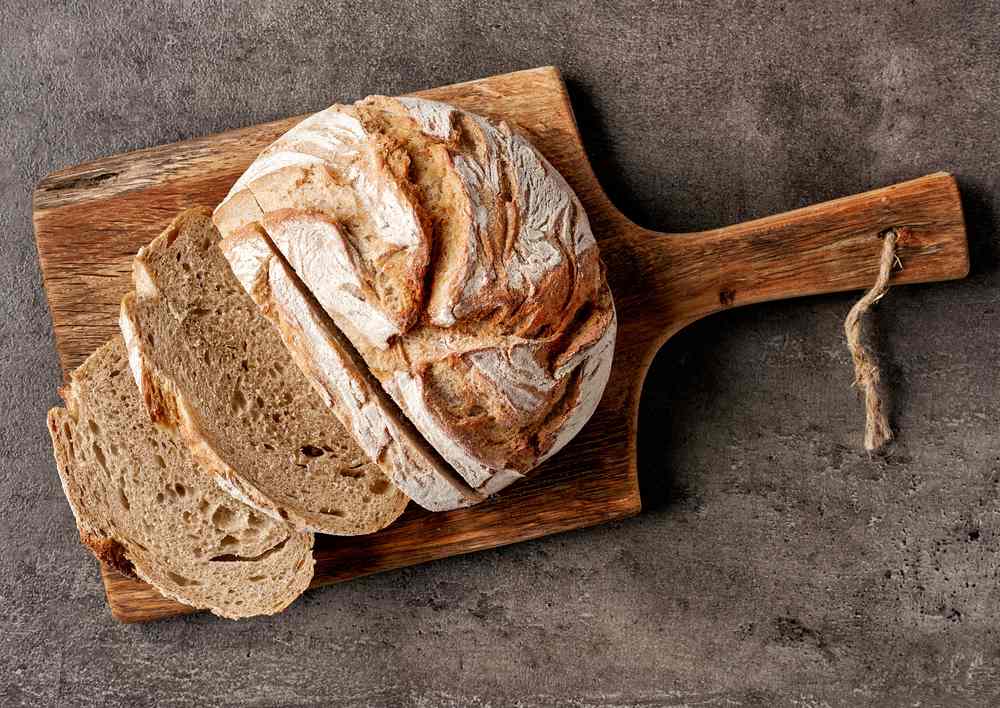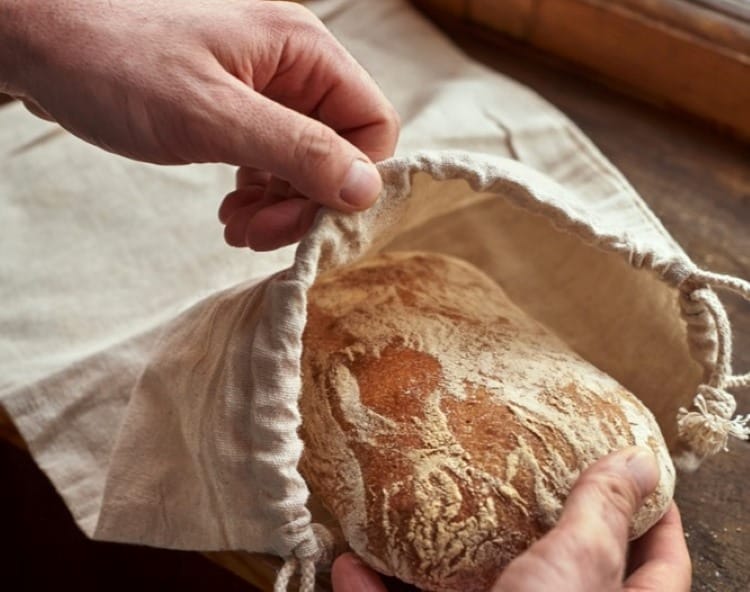We may earn money or products from the companies mentioned in this post.
(Last Updated On: September 1, 2023)Sourdough bread is made without preservatives, meaning that its shelf-life won’t be as long as store-bought bread. On the flip side, as a fermented bread, sourdough can have a longer shelf life compared to other types of homemade bread.
Still, it’s essential to know the best methods of storing and freezing sourdough bread to keep it fresh, moist, and delicious.
In this article, you’ll find all you need to know about keeping sourdough bread fresh – whether that’s at room temperature, or freezing it for longer storage.
We’ll also teach you how to thaw and refresh frozen sourdough bread so that it tastes just as good as when you first baked it. Additionally, you’ll come across useful tips to prevent drying out and freezer burn, as well as ideas to make the most of leftover bread.
Our Tried-and-True Favorites:

Keeping Sourdough Bread Fresh
at Room Temperature
We all want to keep our sourdough bread fresh for as long as possible. Unless, that is, you’re like us and devour it within the day! Here are our tips:
When storing a whole loaf at room temperature, it’s important to control the humidity and airflow around the bread. Aim for a temperature between 68-77°F (20-25°C), as higher or lower temperatures can impact the bread’s quality and mold growth.
When storing sliced sourdough bread, place the sliced side down, then cover. I know this seems easy, but still worth being mentioned as it will help maintain the bread’s freshness while still allowing air to circulate around the loaf.
Remember to consider the humidity in your area as it can affect storage. In high humidity environments, be careful not to create too much trapped moisture when storing bread, causing mold. Conversely, in low humidity areas, make sure your storage method retains enough moisture to prevent the bread from becoming stale too quickly.
*Below are my favorite ways for storing sourdough bread*
Bee’s Wrap – Large Bread Wrap or Bee’s Wrap – XXL Roll
I love using Bee’s Wrap for keeping my sourdough bread fresh. Bee’s wrap creates a breathable seal, allowing your bread to retain it’s moisture, but doesn’t seal it completely like a plastic bag would. And – it’s reusable for up to a year (no plastic wrap waste!).
I simply wrap my bread tightly and store it in my breadbox or a cool, dry place. Make sure your bread is completely cooled before using the bee’s wrap. Also, it’s important to clean the wrap properly after each use with cool water and gentle soap to ensure it lasts as long as possible.
Acacia Wood Dome Server or Bread Bin with Linen Bread Bag
Another option is to use a dome server or bread bin. Isn’t the Acacia wood server simply beautiful?! Not only does it look great sitting on your countertop, but you’re able to show off your hard work and scoring designs!
A bread box can also work well to keep your bread fresh. Both of these options create that breathable seal, while maintaining a good balance of humidity and airflow.
Reusable Bread Bags – 2 pack
If you want to use a simple bread bag, these two are great options. They’re not big, and don’t take up much space – allowing you to put them away when you’re not using them.
And just like the storage options above, these bread bags keep your sourdough fresh and allowing it to breath while still protecting it from drying out.
Freezing Sourdough Bread
Freezing sourdough bread is a great way to preserve its freshness and enjoy it anytime. To make sure you get the best results when freezing sourdough bread, follow these steps:
- Allow the bread to cool completely: Before freezing, ensure your sourdough bread has cooled to room temperature. This step prevents condensation from forming inside the freezer bag or wrapping, which can lead to sogginess or freezer burn.
- Wrap the bread: To protect your sourdough from freezer burn, first wrap the entire loaf or individual slices in bee’s wrap or plastic wrap. Then, create a second layer by wrapping the bread in aluminum foil. Make sure to seal all the edges tightly.
- Use a freezer-safe bag: For added protection and to prevent any unwanted smells from the freezer entering your bread, place the wrapped loaf or slices in a Ziploc bag or another freezer-safe bag. Press out any excess air and seal the bag tightly.
- Label and date the bag: It’s important to label your freezer bag with the type of bread and the date you’re freezing it. This will help you keep track of how long the bread has been in the freezer and ensure you consume it within 2-3 months for the best texture and flavor.
- Find a place in the freezer: Try to find a flat surface in your freezer where the bread can lay flat without being squished by other items. Freezing your sourdough bread flat helps prevent it from becoming misshapen during storage.
- Thawing the bread: When you’re ready to thaw your frozen sourdough, remove it from the freezer and allow it to thaw at room temperature. I keep the bee’s wrap and aluminum foil on for the first hour or so, to retain moisture and prevent it from drying out. Next, I take off the coverings and set it under my dome or in my bread bag to finish thawing.
*This is what has worked well for me – but always take into consideration your environment. Do you live in a dry or humid area? Is it a hot summer or freezing cold winter? Those factors may change the thawing process for you slightly.

Tips to Prevent Drying Out and Freezer Burn
Making sourdough bread takes time, so make sure you take time to store it properly, too. Quality storage materials and good methods are an essential step for the longevity and taste of your sourdough bread.
- Wrap your bread tightly. Start by wrapping your sourdough bread in beeswax wrap, plastic wrap, or aluminum foil. This creates a barrier against air and moisture, which are the main culprits behind drying out and freezer burn. Ensure that the wrap hugs the bread snugly, leaving no gaps.
- Choose the right container. Use airtight, freezer-safe containers or freezer-safe bags to store your wrapped bread. This adds an extra layer of protection, ensuring that air and moisture don’t affect the quality of your bread. Remember to use containers or bags that are the right size for your bread, minimizing the air space inside. Sometimes I go to these 2-gallon freezer safe bags for larger loaves of bread.
- Label and date your bread. Mark the date on your container or bag so that you know how long it’s been stored in the freezer. It’s recommended to consume frozen sourdough bread within three months for the best quality.
- Avoid overstocking your freezer. To maintain consistent temperatures, avoid overloading your freezer with items. This ensures that the bread freezes evenly, preventing ice crystals from forming on its surface, which can lead to freezer burn.

Thawing and Refreshing Sourdough Bread
To thaw sourdough bread, take it out of the freezer and let it thaw for roughly one hour. Then remove any plastic wrap or foil covering the loaf. Place the bread in your bread bag or box, and let it continue to thaw at room temperature for a few hours.
If you’re in a hurry (or are just too excited to eat it!), you can gently pry a slice or two from the frozen loaf and pop them in the toaster on a low setting for a quicker thaw.
Once your sourdough bread has thawed, it’s time to refresh it to bring back its delicious, crusty texture. Preheat your oven to 375°F (190°C). Place the thawed loaf directly on the oven rack and heat it for 10-15 minutes, until it’s warmed through and has a crisp crust. Be careful not to overheat it, as this can make the bread too dry. Sometimes I’ve spritzed a little water on top, to keep it from drying out too much as well.
If your sourdough bread has been sliced before freezing, you can refresh individual slices in the toaster or an oven. For the toaster, set it to a medium-low setting and keep a close eye on the bread to avoid over-toasting. In the case of an oven, preheat it to 375°F (190°C) and place the slices on a baking sheet, heating them for 5-10 minutes.
Making the Most of Leftover Bread
Leftover sourdough bread doesn’t have to go to waste. With a little creativity, you can repurpose it into delicious dishes that reduce food waste and save you money. Here are some ideas to make the most of your leftover sourdough bread.
Bread crumbs: Transform stale bread into bread crumbs to add a crispy coating to dishes or use as a thickener for soups and casseroles. To make bread crumbs, simply tear or cut the leftover sourdough bread into smaller pieces, and let them dry on your countertop for a day or two. Once dried, process them in a food processor until you reach the desired consistency. Store the bread crumbs in an airtight container.
Croutons: Add a crunchy element to your salads, soups and other dishes by making homemade croutons. To make croutons, preheat your oven to 375°F (190°C). Cut the leftover sourdough bread into bite-sized cubes. In a bowl, mix the bread cubes with a little olive oil, salt, and your choice of herbs and spices. Spread the seasoned bread cubes out on a baking sheet, and bake for 10-15 minutes, or until golden brown and crisp. Allow croutons to cool completely before using them or store them in an airtight container.
Freezing: If you don’t plan to use the leftover sourdough bread immediately, you can freeze it to extend its shelf life. Before freezing, make sure the bread is completely cool.
By repurposing your leftover sourdough bread, you not only reduce food waste but also discover new ways to enhance your favorite dishes!
My question is, who actually has leftover bread?? 🙂 (not us!)








